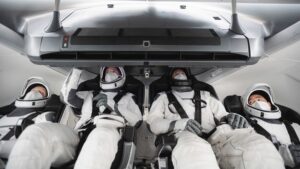Crew-2 on schedule for April launch while next Starliner flight delayed
By Jeff Foust

WASHINGTON — NASA officials said March 1 that the next SpaceX commercial crew mission to the International Space Station remains on schedule for late April, but that a Boeing uncrewed test flight is facing further delays.
The Crew-2 mission, a flight of SpaceX’s Crew Dragon spacecraft carrying astronauts from NASA, the European Space Agency and Japan Aerospace Exploration Agency to the station, remains on track for a launch no earlier than April 20, agency officials said at a briefing.
The actual launch date may shift by a few days “to more optimize some of the orbital mechanics and the launch opportunities,” said Steve Stich, manager of NASA’s commercial crew program. The agency is trying to fit the mission in during a window between the mid-April departure of the Soyuz MS-17 spacecraft and a “beta cutout” in May when sun angles restrict ISS activities.
That schedule also has to accommodate the return of the Crew-1 mission on the Crew Dragon currently docked to the station. Stich said the goal is to have that spacecraft return to Earth by May 9 to avoid “dark landing opportunities” for the spacecraft’s splashdown.
Neither NASA nor SpaceX see any major challenges to launching in late April, even after the shutdown of a Merlin engine on a Feb. 15 Falcon 9 launch that prevented the booster from landing. “Everybody is on track and ready for an April 20 launch readiness date,” Benji Reed, senior director of human spaceflight programs at SpaceX, said at the briefing.
The Crew-2 mission will be the third Crew Dragon flight to carry astronauts, but the first such spacecraft to be reused. The Crew Dragon capsule for Crew-2 previously flew the Demo-2 mission last year, and workers have spent the last several months refurbishing it for the upcoming flight.
SpaceX has been working with NASA on the refurbishment process, determining what components need to be replaced to ensure crew safety and what can be kept. “I can happily say that the vast majority of the vehicle is flight-proven,” Reed said. Some valves and parts of the thermal protection system are being changed, he said, along with parachutes that are replaced after every flight. “Otherwise, it’s really the same vehicle that’s very carefully inspected, carefully prepared and refurbished as needed, and ready to fly.”
SpaceX has also “beefed up” the structure of the spacecraft to improve the acceptable wind speeds and wave heights for splashdown, thus expanding the landing opportunities. “This is one of the most important updates that we’ve done on this Dragon,” he said.
Stich added the spacecraft has improved pad abort performance in the form of additional propellant for the SuperDraco thrusters, which also improves launch constraints by allowing launches when there are stronger onshore winds. “I really look at this flight as an abort enhancement flight,” he said.
Starliner delay
The Crew-2 mission was scheduled to be the third crew-capable spacecraft to visit the ISS in April. It will be preceded by the Soyuz MS-18 spacecraft, set for launch April 9.
NASA had scheduled the launch Boeing’s CST-100 Starliner commercial crew vehicle on the uncrewed Orbital Flight Test (OFT) 2 mission for April 2. That mission will be a reflight of the original, flawed OFT mission in December 2019 that was unable to dock with the station because of software problems.
It’s now unlikely, though, that the mission, recently delayed from late March, will be ready to launch in early April. “We are going to move off of 4/2,” Stich said. Preparations for the mission are about two weeks behind schedule, he said, in part because of winter weather and associated power outages in the Houston area that delayed software testing for the spacecraft by a week.
It’s unclear when the OFT-2 can take place because of the upcoming Soyuz and Crew-2 missions, and then availability on the Eastern Range at Cape Canaveral for the Atlas 5 launch of the mission. “It’s a very busy timeframe on the space station,” Stich said. “And then it’s a busy time on the range, so we’re working hand-in-hand with Boeing to figure out when that launch date will be. We’ll have to stand by for further developments on exactly when that flight will fly.”
March 2, 2021 at 04:44PM
via SpaceNews read more...

Post a Comment